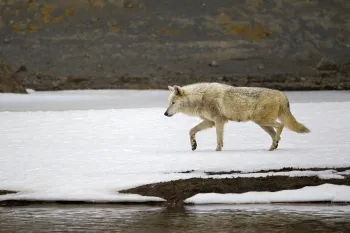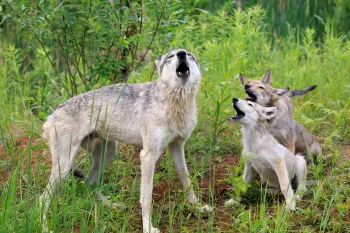In the latest development in the war on wolves, the U.S. Fish and Wildlife Service recently said it will not release a National Wolf Recovery Plan that it had previously announced it would make public next month. This news alone is sure to be a major disappointment for any and all invested in a practical, fact-based approach to wolf conservation.
In explaining its reasoning, the agency gives even more cause for concern. The announcement goes on to say that “a recovery plan for the listed gray wolf entities would not promote their conservation because listing is no longer appropriate” under the Endangered Species Act. Rather than producing a comprehensive and science-backed approach to wolf conservation, the Trump administration appears to be redoubling its efforts to delist wolves across the U.S.
Simply put, this conclusion flies in the face of the best available science, which the agency is required to examine in making its endangered species listing decisions. It is a fact that wolves in the Lower 48 states have not recovered from the historic killing campaigns that almost wiped them out. Today, they continue to face serious threats: poaching, habitat loss, and many state agencies with bad-as-can-be track records when it comes to wolf coexistence.
Given this context—and a decades-long painful cycle of hasty delisting attempts based on outdated criteria and subsequent litigation—a National Wolf Recovery Plan is desperately needed. It is long past time for a new approach, and the Fish and Wildlife Service should be leading the way. There were even positive signs that the agency was finally on the right track.
Now, without a National Wolf Recovery Plan, we are one step further from a process that would have engaged the public—including animal advocates and ranchers—to develop a unified approach based on current, science-based benchmarks for recovery, rather than politics. However, this move is consistent with other signals from the administration—it seems determined to delist wolves nationwide.
That would be a grave mistake. Continued federal protections for wolves are essential. Without protection under the Endangered Species Act, wolf management will be left to the states. Unfortunately, experience shows just how dangerous that is.
Wolves are already delisted in the Northern Rocky Mountains (including all of Idaho, Montana and Wyoming), where they face year-round hunting seasons in many areas, snaring, baiting, trapping and aerial gunning. Hunters can chase down and corner wolves with hounds and kill entire wolf families in their dens in Idaho and Wyoming, and bounty-like payments are made for dead wolves in Idaho and Montana. And just last year, a Wyoming man used a snowmobile to run down a young wolf, who was then muzzled with duct tape, dragged into a bar and posed for photos with patrons before being killed with a shot to the head. Although he was recently indicted, many called out the state for an initially underwhelming response to such an incredibly cruel act.
This behavior is as unsustainable as it is cruel. Scientific research demonstrates that trophy hunting and trapping wolves can start a deadly ripple effect that extends harm far beyond the original wolf killed. Killing a single wolf can result in the loss of entire packs by causing the loss of dependent offspring and disrupting the pack’s social structure. The human-caused loss of breeding females has been shown to cause complete dissolution of the pack and abandonment of territory. Trophy hunting and trapping in states with established wolf populations can harm wolf recovery in neighboring areas.
One previous, and disastrous, Wisconsin hunt in 2021 killed more than 200 wolves in less than 60 hours. Wisconsin state law mandates a wolf hunt when the animals are not listed under the Endangered Species Act, so if wolves lose federal protections, the state would have to hold a hunt—which includes shooting, trapping, snaring and even hounding—at the next season. Michigan and Minnesota would not be far behind.
Perhaps most frustrating of all, killing wolves doesn’t actually make farmed animals, pets or people meaningfully safer. Fewer than 1% of cows and sheep are killed by any kind of native carnivore, including wolves, and there are proven nonlethal options that are more effective for wolf coexistence. And wolves are simply not a threat to people. In fact, there has never been a documented fatal wolf attack on a human in the Lower 48 states.
Entrusting the lives of all wolves in the Lower 48 to management by individual states is not only misguided, but also out of step with the will of the American people.
Just this year, survey results showed that the vast majority of Americans, including ranchers and those who live close to wolves, support their continued protection under the Endangered Species Act.
We urge the federal government to reverse course and focus on a science-backed approach to wolf recovery we can all get behind.
Kitty Block is president and CEO of Humane World for Animals. Follow Kitty Block on X. Sara Amundson is president of Humane World Action Fund.




